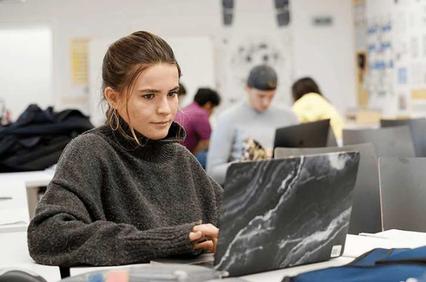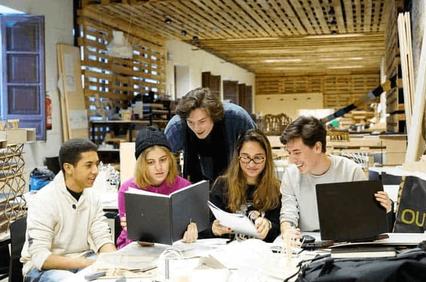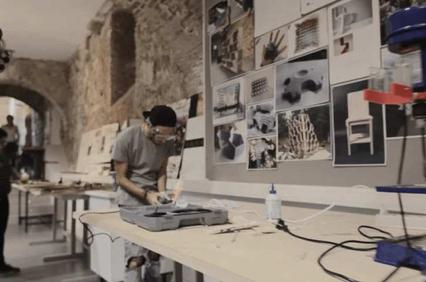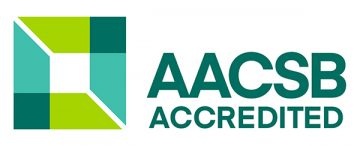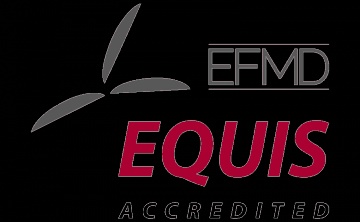Dual Degree in Business Administration & Design
Dual Degree in Business Administration & Design
Boost businesses with design
- Home
- Studies
- Undergraduate Degrees
- Dual Degree In Business Administration & Design
A Unique Dual Degree in Business Administration & Design
A Unique Dual Degree in Business Administration & Design
The study plan for the Dual Degree in Business Administration & Design at IE University has been designed with the prestigious academic experience at its core, our academic faculty’s expert knowledge and research in each area, and the linkages between the University and the professional world.
The Dual Degree in Business Administration & Design aims to teach young ambitious individuals to build the proper skill set to become professionals capable of facing real-world challenges.
Through our hands-on teaching methodology, students from the Dual Dual Degree in Business Administration & Design will find the perfect ideal balance between what is studied throughout their degree and the projects that are applied based on real-world scenarios.
This will aid them to develop profiles that are able to adapt to new trends happening now in the 21st century.

WANT TO KNOW MORE?
Dual Degree in Business Administration & Design STUDY PLAN
Dual Degree in Business Administration & Design STUDY PLAN
LEARN MORE ABOUT OUR Dual Degree in Business Administration & Design
LEARN MORE ABOUT OUR Dual Degree in Business Administration & Design
FIRST YEAR
From their very first semester, students take a deep dive into the worlds of Design and Business. On the design side, you’ll plunge into the history of design and obtain basic industry skills before learning visualization and representation techniques. Your design knowledge will be put to the test in the Design Studio both semesters. On the business side, you’ll get a taste of each of the fundamental disciplines in this field: business mathematics, accounting, people skills, finance, business law, and management tools. These foundations will set the stage for the next four years.
SECOND YEAR
With a strong knowledge base in the worlds of Design and Business, it’s time to build on the basics. In their second year, students capitalize on the business degree by exploring more specific topics in courses such as Marketing, Financial Reporting, and Micro- and Macroeconomics. In the design program, you’ll discover the field through the lens of humanities, familiarizing yourself with Psychology and User-Centered Design; Sociology and Culture; and Sustainability. Design Studio continues this year, with the first semester focusing on Visual Design and the second semester looking at Product Design.
THIRD YEAR
The third year is all about solidifying students’ understanding of both fields and how they interact. Students will study advanced business topics like Statistics and Data Analysis; the Global Economic Environment; Organizational Behavior; and Entrepreneurship and Innovation. The design program gets specific with courses such as Ethnography; Typography, Layout, and Presentation; and Interactive and Digital Tools. The theme of this year’s Design Studio is Spatial Design—a particularly relevant topic in the world of business innovation.
FOURTH YEAR
This year, students have more say in their academic journey. Pick the electives that interest you most—study abroad, complete an internship… the choice is yours. Courses in the Design program will give you a big-picture perspective, with topics such as Design Methodologies; Processes and Design Theory; Design Narratives; and more. On the BBA side, courses get even more advanced: Business-Driven Information Technologies; Human Capital Management; Venture Creation and Planning; and Operations Management. In the spring, you’ll explore Research Techniques, a transversal skill that will prove useful no matter your career path.
FIFTH YEAR
The fifth and final year brings interesting courses like Contemporary Design Trends, Fabrication Technologies, Supply Chain Management, and Strategies for the Multinational Corporation. In the IE Module, you will solidify your understanding of how the fields of Design and Business Administration fit together. You’ll also take on your final Design Studio topic, Strategic Design.
In the final semester of this Dual Degree, students will show everything they’ve learned in the past four and a half years in their Final Projects (one for each program). They will also compile a Design Portfolio to show off everything they created throughout their studies.
WATCH THIS ENTREPRENEURSHIP MASTERCLASS
WATCH THIS ENTREPRENEURSHIP MASTERCLASS
Join Waya Quiviger's masterclass on social entrepreneurship; learn sustainable, impactful business models and real-world profit-with-purpose examples. Be a change-maker!
Learning a new language can open up a world of new opportunities
Learning a new language can open up a world of new opportunities
IE University considers multiple language acquisition to be a key element of its educational model, leading to success in both work and study.
The Language Center at IEU is proud to offer students the possibility to study a wide range of languages, including French, German, Portuguese, Chinese, Arabic, Spanish, and English. With such a large variety of options, our students are able to personalize their academic path to meet their future career plans and objectives.

The Language Center at IEU
The Language Center at IEU
The Language Center helps students develop their multilingual communicative skills to help them flourish in the international labor market.
Acreditations
Acreditations
COMPETENCES
COMPETENCES
Basic competences
GENERAL COMPETENCES
- Analyze companies’ needs to adapt instruments, products and services to their specific features.
- Organize and plan for situations that pose a challenge for decision-making in light of a company’s internal problems.
- Collect, analyze and summarize information from different sources in order to later apply it to business management.
- Ability to communicate in English orally and in writing.
- Adapt a company’s products and services using data analysis instruments.
- Define mechanisms enabling adaptation to new situations in the business environment.
- Develop a basic ability to spell out relevant outcomes through practical application in different fields of design, incorporating information from other disciplines.
- Understand design’s impact and implications for contemporary society and be capable of offering solutions and actively participating in creation and conceptualization processes.
- Suggest and implement proposals involving creative activities to provide added value to the everyday activities of companies and society.
- Understand and use graphic language and tools to present, simulate and resolve design problems.
- Produce relevant outcomes as a result of hands-on involvement in different fields of design, including products, graphics or interfaces, and incorporating information from other disciplines, in order to develop new offerings and solutions and convey and pass on the knowledge acquired.
- Apply knowledge of modeling, visualization, materials technology and production techniques when conducting design projects, paying attention to their viability and social, technological and environmental constraints.
PROGRAM-SPECIFIC COMPETENCES
- Apply solutions that are efficient in a competitive market based on national and international economic knowledge.
- Manage a small company or organization, understanding its competitive and institutional position and identifying its strengths and weaknesses.
- Understand the duties of the different management bodies of a medium or large company or organization in order to perform the management tasks entrusted to it.
- Evaluate a company’s current situation and foreseeable future in terms of specific situations and markets, using relevant records to enable decision-making.
- Create management projects for a company as a whole or its different functional units, identifying relevant economic information sources and their contents.
- Recognize a company’s economic, global and structural situation within the labor market in which it operates, including the subject and/or the company.
- Interpret the current socioeconomic context based on basic historical, philosophical and political knowledge.
- Apply the appropriate business diagnostics tools and techniques to each stage of development in order to obtain better evaluation and decision-making at a company.
- Use the most appropriate models and research methods for a given company in light of its context and normal spheres of business development.
- Use knowledge of information and communication technologies in all professional activities.
- Apply professional judgment based on using technical instruments to analyze problems.
- Identify and manage the conditions enabling employees’ personal development in everyday strategic business settings.
- Identify the differences, problems and needs present within an organization in order to properly manage them.
- Access, recognize and use relevant data and information in business settings.
- Create recommendations for action by applying the legal framework in force.
- Use cost accounting to make company decisions in collaboration with different corporate stakeholders.
- Apply novel business ideas in order to design an entrepreneurial reality.
- Use market strategies in different sectors analytically.
- Compile, distribute and present statistical data for software development in economics settings.
- Apply IT solutions to corporate issues, taking the latest advances in the sector into consideration.
- Devise, plan and conduct design projects in line with requirements and the technical, functional, aesthetic and communication constraints of a brief.
- Develop the ability to create designs that simultaneously meet aesthetic, theoretical and technical requirements.
- Understand and interpret historical, theoretical and critical texts in the fields of design, art and architecture in a relevant and logical manner.
- Learn relevant methods to apply the creative process to professional situations and innovative problem-solving.
- Interpret and critically evaluate final products and design projects created by yourself and others.
- Learn relevant research methods used in project design and theory, analysis and criticism in the fields of design and art.
- Graphically structure and prioritize verbal information.
- Present and explain the outcomes and work processes used to obtain objects you have designed, both orally and in writing.
- Learn and master the graphic elements used in design and visual communication and the tools used to create and produce them, using a variety of physical, audiovisual or digital means.
- Implement strategies and methodologies to obtain innovative solutions to creative briefs.
- Acquire basic knowledge of information presentation and visualization techniques.
- Use basic digital expression techniques (programming, interaction and multimedia resources) in order to conduct design projects.
- Use digital tools to bring communicative and expressive actions in line with their intended use through design solutions.
- Understand industrial and artisanal manufacturing processes as well as their main features and limitations.
- Recognize the ways in which digital manufacturing can contribute to design, as well as its main features and limitations.
- Master the aesthetic fundamentals of design, including morphology, structure, color, space, volume, tectonics, typography and composition.
- Master the fundamentals of typography, mockup and presentation techniques.
- Apply basic social science knowledge to design projects, including elements from psychology, analytical fields, sociology, programming, ethnography, social science research methods, etc.
- Understand how to apply social science statistics and analytical tools to design projects.
- Propose research and innovation strategies with the aim of meeting the functionality, needs and materials expectations of design.
- Recognize and make use of the advantages offered by programming when it is used as a design tool.
- Add technology and digital manufacturing to the list of tools available to you to solve problems related to proposed design statements.
- Understand the materials and materialities used as a medium for both physical and digital visual design.
- Understand the media and materialities that make product design possible, both for physical and digital products.
- Understand the materials and materialities that define spatial design.
- Understand the structures used to define a strategic design project.
TRANSVERSAL COMPETENCES
- Identify the main cultural identity traits that characterize today’s world by understanding the main contemporary ideological trends.
- Behave professionally in accordance with the core principles and ethics of the profession.
- Manage unforeseen situations by being able to adapt to organizational changes.
- Use knowledge of the discipline to analyze and evaluate current situations.
- Form a part of interdisciplinary and multicultural teams to achieve shared goals in a diverse environment.
- Work actively in an international context.
APPLICABLE REGULATIONS OF THE PROGRAM
APPLICABLE REGULATIONS OF THE PROGRAM
